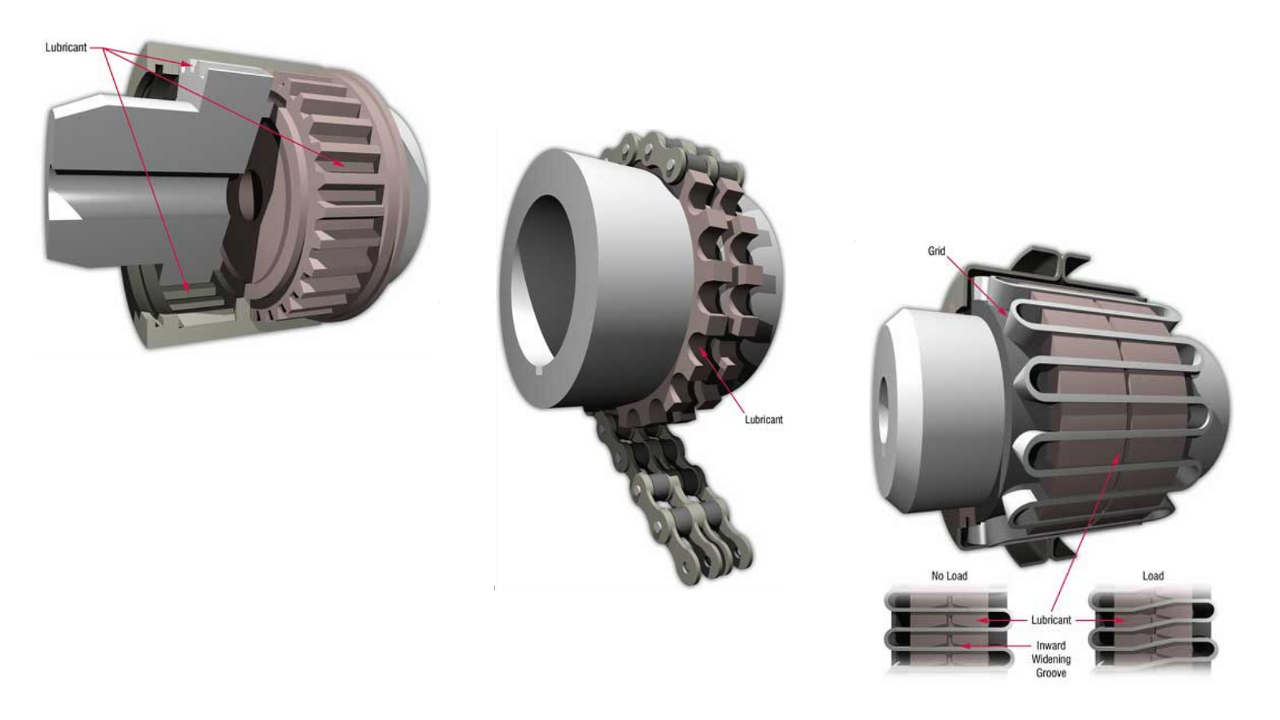Power Transmission: Select Proper Re-Lubrication to Extend Bearing Life
Adding the correct amount of lubrication at each re-lubricating interval is essential to achieve maximum bearing life. An incorrect re-lubrication quantity, whether it’s too much or too little, can actually decrease bearing life.
Insufficient lubrication
Not using enough lubrication will lead to a breakdown, which may cause premature metal-to-metal contact between rollers and raceways. You also need to remember that grease acts as a barrier or seal, and aids in decreasing the incursion of contaminates into the bearing. When sufficient lubrication isn’t present, the sealing ability of bearings is decreased. Contaminates can also more easily enter the bearing.
Excessive lubrication
Too much lubricant can cause its share of problems. For example, in a high-speed application, the bearing could actually overheat due to the amount of grease being pumped into the bearing. As the bearing continually churns excess grease, the continuous mixing generates heat within the bearing housing. If more lubrication is added, the bearing will eventually overheat and fail.
The majority of mounted bearings have seals that purge excess lubrication. Check with your mounted-bearing supplier to ensure the bearings in question have purgeable seals. These seals allow excess grease to pass through the sealed area and out of the bearing. This purging is spread out over time, but will help decrease the chance of over filling a bearing (Figure 1).
Re-lubrication quantity
There are two proper ways to determine the correct re-lubrication quantity. The first method is to contact the mounted-bearing manufacturer and request a recommendation, which is based upon your specific application. If that’s not possible, your second option is to calculate the correct re-lubrication quantity using the following equations and examples: To manually determine the correct re-lubrication quantity you must first obtain this information:
1. D=Bearing outer diameter (mm) 2. B=Bearing width (mm) 3. Q=Re-lubrication interval factor • Use Q=0.002 if you have a weekly re-lube interval • Use Q=0.003 if you have a monthly re-lube interval • Use Q=0.004 if you have a yearly re-lube interval The re-lubrication interval should’ve been determined prior to this exercise. Refer to the instruction manual supplied with the mounted bearing or see the column in the PEM February 2004 issue (Determining the Proper Re-lubrication Interval To Maximize Mounted Bearing Life). 4. Re-lubrication quantity equations: • Grease Quantity (g)=D x B x Q or • Grease Quantity (oz.)=(D x B x Q)/28.35
The following examples will better explain the steps to follow to calculate the exact re-lubrication quantity:
Example 1
210 series 1-15/16-inch set-screw ball bearing insert Re-lubrication interval=weekly Envelop dimensions, such as the outer diameter and width, should be given in the mounted-bearing manufacturers catalogue. For this example, a DODGE 210 series SC 1-15/16-inch ball-bearing insert was chosen. 1. Determine: D=Bearing Outer Diameter (mm) D=90mm 2. Determine: B=Bearing Width (mm) B=22mm 3. Determine: Q=Re-Lubrication Interval Factor Given: Q=0.002 (weekly) You now have all the needed information to use the following equations and determine the correct grease quantity:
• Re-Lube Quantity (g)=D x B x Q • Re-Lube Quantity (g)=90mm x 22mm x 0.002=3.96 (g) or • Re-Lube Quantity (oz.)=(D x B x Q)/28.35 • Re-Lube Quantity (oz.)=(90mm x 22mm x 0.002)/28.35=.14 (oz.)
Example 2
22213K 2-7/16-inch spherical roller bearing • Re-lubrication interval=monthly For this example, a DODGE Imperial 2-7/16-inch insert was chosen. All needed dimensions were found in the manufacturer’s bearing engineering catalogue. 1. Determine: D=Bearing Outer Diameter (mm) D=120mm 2. Determine: B=Bearing Width (mm) B=32.3mm 3.Determine: Q=Re-Lubrication Interval Factor Given: Q=0.003 (monthly)
You now have all the information you need to use the following equations and determine the correct grease quantity:
• Re-Lube Quantity (g)=D x B x Q • Re-Lube Quantity (g)=120mm x 32.3mm x 0.003=11.6 grams or • Re-Lube Quantity (oz.)=(D x B x Q)/28.35 • Re-Lube Quantity (oz.)=(120mm x 32.3mm x 0.003)/28.35=.41 oz
Notice that all calculations deal with the bearing insert and not the bearing housing. In most cases, when determining the correct re-lubrication quantity, the housing style doesn’t play a significant role. The amounts calculated in the two examples are sufficient to replenish the grease supply within bearing internals, and displace degraded lubricant.
Determining the correct re-lubrication quantity is essential to achieve maximum mounted-bearing life. It’s estimated that 90 percent of all mounted-bearing failures are lubricant related. Proper re-lubrication quantities ensure that you’re replenishing the bearing with fresh grease and purging the bearing of degraded grease and contaminates.
Taking the time to determine the correct re-lubrication quantity will increase bearing life and decrease maintenance time, which is associated with mounted-bearing failures.
Related Articles
In an ideal world, multiple components could be produced in a single piece, or coupled and installed in perfect alignment. However, in the real world, separate components must be brought together and connected onsite. Couplings are required to transmit rotational forces (torque) between two lengths of shaft, and despite the most rigorous attempts, alignment is never perfect. To maximize the life of components such as bearings and shafts, flexibility must be built in to absorb the residual misalignment that remains after all possible adjustments are made. Proper lubrication of couplings is critical to their performance.
In an ideal world, multiple components could be produced in a single piece, or coupled and installed in perfect alignment. However, in the real world, separate components must be brought together and connected onsite. Couplings are required to transmit rotational forces (torque) between two lengths of shaft, and despite the most rigorous attempts, alignment is never perfect. To maximize the life of components such as bearings and shafts, flexibility must be built in to absorb the residual misalignment that remains after all possible adjustments are made. Proper lubrication of couplings is critical to their performance.
See More
The goal of every lubrication program should be to ensure that all equipment receives and maintains the proper levels of lubrication such that no equipment fails due to inadequate or improper lubrication. In order for this to happen, we must follow the 5R's of lubrication - right lubricant, right condition, right location, right amount, right frequency.
The goal of every lubrication program should be to ensure that all equipment receives and maintains the proper levels of lubrication such that no equipment fails due to inadequate or improper lubrication. In order for this to happen, we must follow the 5R's of lubrication - right lubricant, right condition, right location, right amount, right frequency.
See More
Most, if not all, companies use CMMS systems to oversee their maintenance activities. From home-grown systems to complete ERP systems, leveraging technology allows companies to more efficiently and effectively manage their maintenance, repair and operations activities. So as a core maintenance function, surely routine, lubrication-related preventive and predictive activities such as regreasing motor bearings, taking oil samples, and executing oil top-offs and inspections belong in the CMMS system like any other maintenance task, right?
Most, if not all, companies use CMMS systems to oversee their maintenance activities. From home-grown systems to complete ERP systems, leveraging technology allows companies to more efficiently and effectively manage their maintenance, repair and operations activities. So as a core maintenance function, surely routine, lubrication-related preventive and predictive activities such as regreasing motor bearings, taking oil samples, and executing oil top-offs and inspections belong in the CMMS system like any other maintenance task, right?
See More
Industry spends millions of dollars each year on improved filtration technology in an attempt to reduce particle contamination, with some of the more advanced companies reducing failure rates by up to 90 percent simply by controlling fluid cleanliness. However, in some industries and environments, water is a far more insidious contaminant than solid particles. Water contamination is often overlooked as the primary cause of component failure.
Industry spends millions of dollars each year on improved filtration technology in an attempt to reduce particle contamination, with some of the more advanced companies reducing failure rates by up to 90 percent simply by controlling fluid cleanliness. However, in some industries and environments, water is a far more insidious contaminant than solid particles. Water contamination is often overlooked as the primary cause of component failure.
See More
Ultrasonic technology (UT) has become widely accepted for the detection of leaks in both pressurized and nonpressurized systems. Most compressor service companies and several manufacturers own some type of ultrasonic sensor for pinpointing leaks. It is easy to cost-justify the purchase of an ultrasonic sensor based upon the high cost of energy loss due to leaks. However, there is another application for ultrasound that consumers, nondestructive testing (NDT) organizations, and even developers and manufacturers of ultrasonic sensors are often not aware of or overlook. UT can be used as a means to detect early wear of components such as bearings and gears due to lack of lubrication or overlubrication.
Ultrasonic technology (UT) has become widely accepted for the detection of leaks in both pressurized and nonpressurized systems. Most compressor service companies and several manufacturers own some type of ultrasonic sensor for pinpointing leaks. It is easy to cost-justify the purchase of an ultrasonic sensor based upon the high cost of energy loss due to leaks. However, there is another application for ultrasound that consumers, nondestructive testing (NDT) organizations, and even developers and manufacturers of ultrasonic sensors are often not aware of or overlook. UT can be used as a means to detect early wear of components such as bearings and gears due to lack of lubrication or overlubrication.
See More
Begin by not reading this editorial. Most "old school" lube programs like to hold to the status quo. Editorials like this one threaten their comfort zone. After all, change takes guts . . . it takes imagination . . . it takes commitment. Who's got the time (and courage) for that?
Begin by not reading this editorial. Most "old school" lube programs like to hold to the status quo. Editorials like this one threaten their comfort zone. After all, change takes guts . . . it takes imagination . . . it takes commitment. Who's got the time (and courage) for that?
See More
Using lubrication and oil analysis to enhance machine reliability is really too simple. Behind the appearances of complexity and vale of high science are the most basic of concepts. We can try to make it difficult, but why? With the right tools and a generous amount of training, a seemingly challenging task can be transformed into something almost mundane, but still powerful.
Using lubrication and oil analysis to enhance machine reliability is really too simple. Behind the appearances of complexity and vale of high science are the most basic of concepts. We can try to make it difficult, but why? With the right tools and a generous amount of training, a seemingly challenging task can be transformed into something almost mundane, but still powerful.
See More










